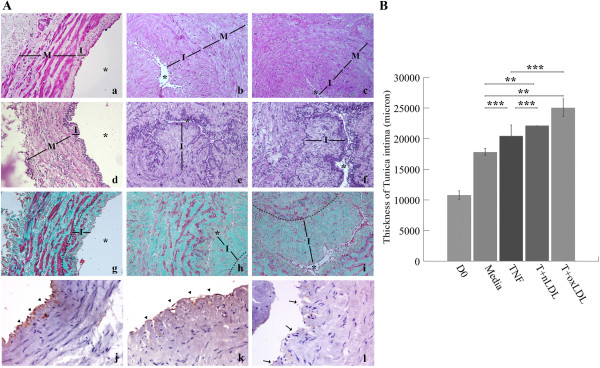Figure 1.

T + LDL induced atherosclerotic plaque like lesion. (A) Photomicrograph of HSV rings (original magnification x 200); harvested on day 0 (a, d, g), and day 14 after cultured with T (5 ng/ml) + nLDL (50 μg/ml) (b, e, h) or T (5 ng/ml) + oxLDL (50 μg/ml) (c, f, i). Histopathologic changes observed by H&E staining (a, b, c), thickening of TI and expansion of extracellular matrix in vascular wall determined by Weigert staining (d, e, f) and Masson Trichrome staining (g, h, i), respectively. * points lumen of HSV ring, I and M localize TI and TM, respectively. The endothelial lining of HSV rings at D0, cultured with TNF-α (5 ng/ml) or T + oxLDL (j, k, l) was localized by immunostaining with anti-VonWillebrand factor (vWf) and peroxidase substrate DAB (original magnification x 400). Arrowheads and arrows point the positive and negative reactivity of EC, respectively. The findings were obtained from one of similar six independent experiments. (B) Graph of thickening of TI compared among HSV rings cultured in medium alone, with TNF-α, T + nLDL, or T + oxLDL to the syngeneic HSV on day 0. The data represent mean ± SEM of T. intimal thickness (μm) of those cultured in medium alone, (n = 6). Significant differences among individual groups are indicated; ** p- valves < 0.05, and *** = not significant.
